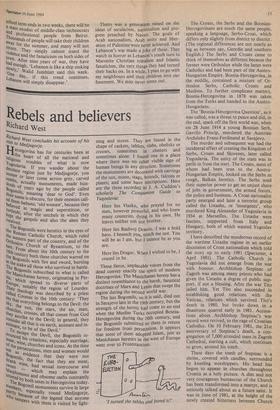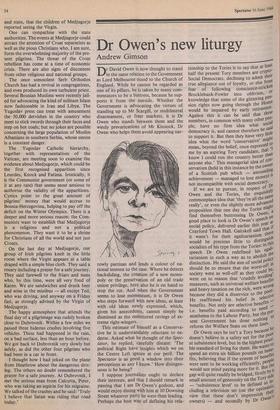Rebels and believers
Richard West
Richard West concludes his account of his visit to Medjugorje. Hercegovina has for centuries been at the heart of all the national and religions troubles of what is now Yugoslavia. If you wander about the desolate region just by Medjugorje, you oner tombs later come across grey, carved rnbs, actually monuments, made hun- dreds ID' Years ago by the people called tP,ilogornils, meaning 'dear to God'. Even eir name is obscure, for their enemies call- i " them babuns, 'old women', because they uelieved
i°rbeshi in magic and superstition, or
Le , after the satchels in which they ^lpt te gospels receivehd. and also the alms they The Bogomils were heretics in the eyes of 0the Roman Catholic Church, which ruled ewestern part of the country, and of the hodox Church of Byzantium, to the e4st. From about the 10th century to the 461 th Bogomils both these churches warred on ,,-,b'ogomils with fire and sword, burning the stake all those who survived in battle. ti,",1;,togomils subscribed to what is called eManichaean heresy, originating in Per- , Which spread to diverse parts of ihtler°iripetite notably °10tgablY the region of Lourdes. sailed f was described by a priest skyCosmas in the 10th century: 'They th everything belongs to the Devil: the the0.1,' the sun, the stars, the air, man, crosses, all that comes from God .."_ey ascribe to the Devil; in general, they ca°11nsider all that is on earth, animate and in- ..rirrlate, to be of the Devil.' 4: 0 escape the Devil, the Bogomils re- niunneed his creations, especially marriage, °fetal!, wine, churches and icons. At the time us 'Le Persecutions, men and women would 4.! as evidence that they were not drugornils, the fact that they ate meat, sw4nork,, v''ine, had sexual intercourse and blas which may explain the Phemous and obscene oaths constantly The hY both sexes in Hercegovina today. riunThe 8egomil monuments survive in large Dartl ers' especially round Medjugorje, ‘,,,h,! tampers with them is visited by light- ning and storm. They are found in the shape of caskets, tablets, slabs, obelisks or crosses, sometimes in clusters and sometimes alone. I found one in a place where there was no other visible sign of human beings in any direction. Sometimes the monuments are decorated with carvings of the sun, moon, stags, hounds, falcons or plants; and some have inscriptions. Here are the three recorded in J. A. Cuddon's scholarly The Companion Guide to Yugoslavia:
Here lies Vlatko, who prayed for no men, however powerful, and who knew many countries, dying in his own. He leaves neither son Radivo nor brother.
Here lies seech Drascic. I was a bold hero. I be
You, touch me not. You will be as I am, but I cannot be as you are.
Here lies Dragac. When I wished to be, I ceased to be.
These fierce, implacable voices from the dead convey exactly the spirit of modern distinct resemblance to the harsh, fanatical doctrines of Marx and Lenin that swept the Hercegovina. The Manichaean heresy has a region during the second world war.
The last Bogomils, so it is said, died out in Sarajevo late in the 19th century, but the strength of the heresy had come to an end when the Muslim Turks occupied Bosnia- Hercegovina during the 16th century, and the Bogomils submitted to them in return for freedom from persecution. It appears that most of them adopted Islam, just as in the west of Europe Manichaean heretics
went over to Protestantism.
'I turned the tables and bored it!'
The Croats, the Serbs and the Bosnian- Hercegovinans are much the same people, speaking a language, Serbo-Croat, which differs only slightly from district to district. (The regional differences are not nearly as big as between say, Geordie and southern English.) The Serbs and Croats came to think of themselves as different because the former were Orthodox while the latter were Catholics and had been part of the Austro- Hungarian Empire. Bosnia-Hercegovina, in the middle, contained a mixture of Or- thodox Serbs, Catholic Croats and Muslims. To further complicate matters, Bosnia-Hercegovina in 1878 was taken from the Turks and handed to the Austro- Hungarians.
The 'Bosnia-Hercegovina Question', as it was called, was a threat to peace and did, in the end, spark off the first world war, when on 28 June 1914 a young Bosnian Serb, Gavrilo Princip, murdered the Austrian Archduke Franz-Ferdinand at Sarajevo.
The murder and subsequent war had the incidental effect of creating the Kingdom of Serbs, Croats and Slovenes, later called Yugoslavia. The unity of the state was in perils in from the start. The Croats, most of whom had been true to the Austro- Hungarian Empire, looked on the Serbs as rough, Balkan heretics. The Serbs used their superior power to get an unjust share of jobs in government, the armed forces, the police and business. A Croat nationalist party emerged and later a terrorist group called the Ustashe, or 'insurgents', who murdered King Alexander of Yugoslavia in 1934 at Marseilles. The Ustashe were fascists, supported from Italy and Hungary, both of which wanted Yugoslav territory.
I have described the murderous record of the wartime Ustashe regime in an earlier discussion of Croat nationalism which told the story up to early 1981 (Spectator, 4 April 1981). The Catholic Church in Yugoslavia did not emerge from the war with honour. Archbishop Stepinac of Zagreb was among many priests who had given the Ustashe a degree of public sup- port, if not a blessing. After the war Tito jailed him. Yet Tito also succeeded in establishing good relations with the Vatican, relations which survived Tito's death in 1980, but broke down in a disastrous quarrel early in 1981. Accusa- tions about Archbishop Stepinac's war record were revived, to the rage of Croatian Catholics. On 10 February 1981, the 21st anniversary of Stepinac's death, a con- gregation of 7,000 attended mass in Zagreb Cathedral, starting a cult, which continues to grow, around his tomb.
These days the tomb of Stepinac is a shrine, covered with candles, surrounded by kneeling worshippers. His head has begun to appear in churches throughout Croatia as a holy picture. A dim and not very courageous bureaucrat of the Church has been transformed into a martyr, and is seriously talked about as a future saint. It was in June of 1981, at the height of the newly created bitterness between Church and state, that the children of Medjugorje reported seeing the Virgin.
One can sympathise with the state authorities. The events at Medjugorje could attract the attention of Croat separatists as well as the pious Christians who, I am sure, form the overwhelming majority of the pre- sent pilgrims. The threat of the Croat rebellion has come at a time of economic crisis. There are also signs of discontent from other religious and national groups.
The once somnolent Serb Orthodox Church has had a revival in congregations, and even produced its own turbulent priest.
Several Bosnian Muslims were recently jail- ed for advocating the kind of militant Islam now fashionable in Iran and Libya. The Yugoslav press can treat with amusement the 50,000 dervishes in the country who meet to stick swords through their faces and step on hot coals; but no jokes are possible concerning the large population of Muslim Albanians in southern Serbia, whose unrest is a constant danger.
The Yugoslav Catholic hierarchy, together with representatives of the Vatican, are meeting soon to examine the evidence about Medjugorje, which could be the first recognised apparition since Lourdes, Knock and Fatima. Ironically, it is the Communist government (or some of it at any rate) that seems most anxious to authorise the validity of the apparitions. Cynics point to the great amount of pilgrims' money that would accrue to Bosnia-Hercegovina, helping to pay off the deficit on the Winter Olympics. There is a deeper and more serious reason: the Com- munists want to establish that Medjugorje is a religious and not a political phenomenon. They want it to be a shrine for Christians of all the world and not just Croats.
On the last day at Medjugorje, our group of Irish pilgrims knelt in the little room where the Virgin appears at a table draped with a simple blue cloth. They said a rosary including a prayer for a safe journey. They said farewell to the friars and nuns who, by this time, were all very fond of Karen. We ate sandwiches and drank beer and wine in the minibus — all except Ted, who was driving, and anyway on a Friday fast, as strongly advised by the Virgin of Medjugorje.
The happy atmosphere that attends the final day of a pilgrimage was rudely broken close to Dubrovnik. Within a few miles we passed three hideous crashes involving five vehicles. These had happened in the rain, on a bad surface, less than an hour before. We got back to Dubrovnik very slowly but safely, as did the other four pilgrims who had been in a car in front.
I thought how I had joked on the plane from Heathrow about the dangerous driv- ing. The others no doubt remembered the prayer for a safe journey. At Dubrovnik, I met the serious man from Calcutta, Peter, who was taking an aspirin for his migraine. We talked of the crashes and he said: 'Truly I believe that Satan was riding that road today.'













































 Previous page
Previous page